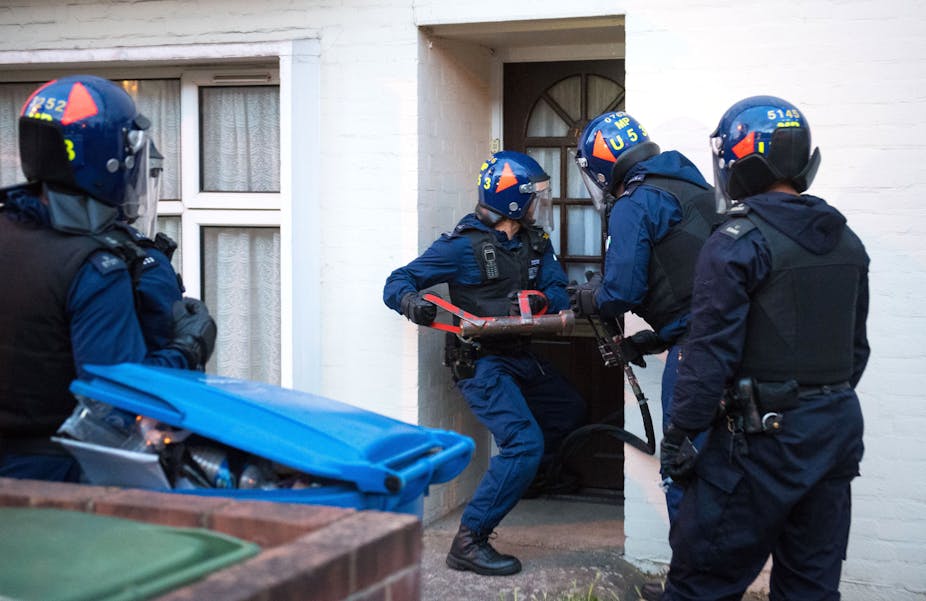Organised crime now costs the UK at least £37 billion – “more than any other national security threat”, according to the Home Office. When it published a new strategy to tackle serious and organised crime in early November, commentators picked on the sharp increase in this figure, up from an estimated £24 billion in 2013. The government says the rise is due to the fact that more areas of life are at risk from serious and organised crime than ever before.
The new strategy is a good step in the recognition of how complex organised crime in the UK is. But it’s still more reactive than proactive and downplays the societal roots of organised crime and the changes that Brexit is likely to bring.
Organised crime is considered first and foremost as a threat to national security – to economic well-being and the strength of the UK’s borders – rather than as a classic policing matter. But this is an approach that has been criticised since it first appeared in 2010, on the basis that including organised crime in the national security agenda gives a distorted image of the actual threat in the UK.
The new strategy confirms the reason the government views organised crime as a national security concern is because of the disruptive capacity that certain organised crime groups have on democracies elsewhere in the world – though these countries aren’t named. This disruption contributes to global imbalance and insecurity, which also affects the the UK. But dealing with organised crime through this lens of national security confuses the way institutions conceptualise organised crime in the UK itself. It exacerbates the rhetoric of fear and risk transferred from other countries, and moves the attention away from the societal roots of the problems that cause organised crime.
A shopping list
Another issue comes from the adjective “serious” that is used as a qualifier of organised crime activity in the UK. The “seriousness” of organised crime is an issue, considering that the National Crime Agency (NCA) now works to stop types of crime that are not necessarily deemed serious. A serious crime is one punishable by more than seven years in prison. For example, while the fight against cybercrime has been at the core of the NCA’s strategic assessments of organised crime in recent years, cybercrime is not always necessarily serious nor organised.

The confusion and overlapping nature of crimes that are harmful, crimes that are serious, and crimes that are organised, makes the new Home Office strategy appear a bit like a shopping list. The crime types it lists range from the exploitation of children to illegal drugs, from illegal firearms to fraud, from money laundering to modern slavery and organised immigration crimes. This anchors the UK’s approach to organised crime in a model of policing known as an activity model, based on disrupting or preventing the activities of organised crime, rather than dismantling the criminal structures behind it.
But there are risks to such an approach. It dismisses the nature of social problems, power structures, and economic inequalities at the core of such crimes. While the new strategy goes a long way in recognising that organised crime has both local impact and an international dimension, the proposals the Home Office make to counter such complexity are vague and incomplete.
The strategy turns the screw on illicit finances and economic crime and says preventing them will be a job for all parts of the state apparatus. Ben Wallace, the security minister, told the Guardian that no stone would be left unturned in following dirty money, whether that’s laundered through expensive assets, in cash-intensive businesses or invested in football clubs or commercial firms.
The fallacy of such a sweeping approach that encompasses the whole government lies in the Home Office’s acknowledgement that it also needs to partner with private sector organisations such as banks or digital data companies. These public-private partnerships do bring benefits in both digital support and the storage and analysis of large data sets. But they pose problems too, particularly as the risks of corruption from organised crime are higher in the private sector than public institutions. And the fight against corruption doesn’t appear as a substantial part of the new strategy.
Power plays
Criminal networks can exploit financial and political power structures to establish their reputation, gain immunity and increase their profits. Some research has started looking at the ways in which some organised crime groups in the UK aim to take control of communities by intimidating people and exercising local political power. But the extent to which this happens in the UK’s business and political arenas is not analysed in depth by law enforcement agencies, who are still struggling to understand and counter this pursuit of power by organised criminals.
Notwithstanding its flaws, the strategy’s focus on preventing organised crime at its roots, with references to youth programmes and community engagement, confirms the need for local partnerships and bottom-up approaches in the fight against organised crime. But the strategy doesn’t give enough prominence to the social causes of organised crime and the harm associated with these crimes in local communities.
The new strategy doesn’t fully consider the evolution of organised crime, nor how it will be countered once the UK leaves the European Union in March 2019. With Brexit around the corner, there will be both opportunities for organised crime groups, particularly trafficking networks, and extra complexities in international policing. The UK needs a much clearer conceptualisation of how organised crime works in the country and a much deeper focus on its social and economic roots than ever before.

